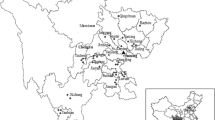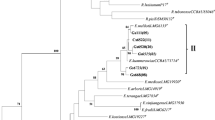Abstract
A total of 128 bacterial test strains originated from Astragalus, Caragana, Gueldenstaedtia, Medicago, Melilotus, Oxytropis, Trifolium, and Vicia grown in Tibet were characterized phenotypically and genomically. Based upon the consensus of grouping results, they were identified as 16 putative species. Twenty-five test strains belonging to seven putative species of Agrobacterium, Bradyrhizobium, and Rhizobium might be nonsymbiotic bacteria and the remaining 103 test strains were symbiotic bacteria belonging to Mesorhizobium, Rhizobium, and Sinorhizobium meliloti. Although no novel taxon was detected in the symbiotic bacteria, several characters including the alkaliphilic psychrotolerance revealed that the Tibetan rhizobia could be ecotypes adapted to the local conditions. The results also demonstrated that frequent lateral transfer of symbiotic genes might have happened in the Tibetan rhizobia since nodC genes similar to that of S. meliloti were found in several Rhizobium test strains and all the Mesorhizobium species had very similar nodC genes despite their genomic background. All of these findings demonstrated that the Tibetan rhizobia were an important resource for further studies on rhizobial ecology and application.





Similar content being viewed by others
References
Aguilar OM, Lopez MV, Riccillo PM (2001) The diversity of rhizobia nodulating beans in Northwest Argentina as a source of more efficient inoculant strains. J Biotechnol 91:181–188
Bogino P, Banchio E, Bonfiglio C, Giordano W (2008) Competitiveness of a Bradyrhizobium sp. strain in soils containing indigenous rhizobia. Curr Microbiol 56:66–72
de Lajudie P, Willems A, Nick G, Moreira F, Molouba F, Hoste B, Torck U, Neyra M, Collins MD, Lindström K, Dreyfus B, Gillis M (1998) Characterization of tropical tree rhizobia and description of Mesorhizobium plurifarium sp. nov. Int J Syst Bacteriol 48:369–382
de Lajudie P, Willems A, Nick G, Mohamed TS, Torck U, Filali-Maltouf A, Kersters K, Dreyfus B, Lindström K, Gillis M (1999) Agrobacterium bv. 1 strains isolated from nodules of tropical legumes. Syst Appl Microbiol 22:119–132
Diouf D, Samba-Mbaye R, Lesueur D, Ba AT, Dreyfus B, de Lajudie P, Neyra M (2007) Genetic diversity of Acacia seyal Del. rhizobial populations indigenous to Senegalese soils in relation to salinity and pH of the sampling sites. Microb Ecol 54:553–566
Fierer N, Jackson RB (2006) The diversity and biogeography of soil bacterial communities. Proc Natl Acad Sci U S A 103:626–631
Gao JL, Sun JG, Li Y, Wang ET, Chen WX (1994) Numerical taxonomy and DNA relatedness of tropical rhizobia isolated from Hainan province of China. Int J Syst Bacteriol 44:151–158
Haukka K, Lindström K, Young JPW (1998) Three phylogenetic groups of nodA and nifH genes in Sinorhizobium, Mesorhizobium test strains from leguminous trees growing in Africa and Latin America. Appl Environ Microbiol 64:419–426
Hurek T, Wagner B, Reinhold-Hurek B (1997) Identification of N2-fixing plant- and fungus-associated Azoarcus species by PCR-based genomic fingerprints. Appl Environ Microbiol 63:4331–4339
Kan FL, Chen ZY, Wang ET, Tian CF, Sui XH, Chen WX (2007) Characterization of symbiotic and endophytic bacteria isolated from root nodules of herbaceous legumes grown in Qinghai–Tibet plateau and in other zones of China. Arch Microbiol 188:103–115
Kumar S, Tamur K, Nei M (2004) MEGA3: integrated software for molecular evolutionary genetics analysis and sequence alignment. Brief Bioinf 5:150–163
Laguerre G, van Berkum P, Amarger N, Prévost D (1997) Genetic diversity of rhizobial symbionts isolated from legume species within the genera Astragalus, Oxytropis, and Onobrychis. Appl Environ Microbiol 63:4748–4758
Li JH, Wang ET, Chen WX (2008) Genetic diversity and potential for promotion of plant growth detected in nodule endophytic bacteria of soybean grown in Heilongjiang Province of China. Soil Biol Biochem 40:238–246
Mhamdi R, Mrabet M, Laguerre G, Tiwari R, Aouani ME (2005) Colonization of Phaseolus vulgaris nodules by Agrobacterium-like strains. Can J Microbiol 51:105–111
Moulin L, Munive A, Dreyfus B, Boivin-Masson C (2001) Nodulation of legumes by members of the ß-subclass of proteobacteria. Nature 411:948–950
Moulin L, Béna G, Boivin-Masson C, Stepkowski T (2004) Phylogenetic analyses of symbiotic nodulation genes support vertical and lateral gene co-transfer within the Bradyrhizobium genus. Mol Phylogenet Evol 30:720–732
Mrabet M, Mnasri B, Romdhane SB, Laguerre G, Aouani ME, Mhamdi R (2006) Agrobacterium strains isolated from root nodules of common bean specifically reduce nodulation by Rhizobium gallicum. FEMS Microbiol Ecol 56:304–309
Ni J (2000) A simulation of biomes on the Tibetan plateau and their responses to global climate change. Mount Res Develop 20:80–89
Normand P, Lapierre P, Tisa LS, Gogarten JP, Alloisio N, Bagnarol E, Bassi CA, Berry AM, Bickhart DM, Choisne N, Couloux A, Cournoyer B, Cruveiller S, Daubin V, Demange N, Francino MP, Goltsman E, Huang Y, Kopp OR, Labarre L, Lapidus A, Lavire C, Marechal J, Martinez M, Mastronunzio JE, Mullin BC, Niemann J, Pujic P, Rawnsley T, Rouy Z, Schenowitz C, Sellstedt A, Tavares F, Tomkins JP, Vallenet D, Valverde C, Wall LG, Wang Y, Medigue C, Benson DR (2007) Genome characteristics of facultatively symbiotic Frankia sp. strains reflect host range and host plant biogeography. Genome Res. 17:7–15
Ponsonnet C, Nesme X (1994) Identification of Agrobacterium strains by PCR–RFLP analysis of pTi and chromosomal regions. Arch Microbiol 16:300–309
Rivas R, Velázquez E, Willems A, Vizcaíno N, Subba-Rao NS, Mateos PF, Gillis M, Dazzo FB, Martínez-Molina E (2002) A new species of Devosia that forms a unique nitrogen-fixing root-nodule symbiosis with the aquatic legume Neptunia natans (L. f.) Druce. Appl Environ Microbiol 68:5217–5222
Saitou N, Nei M (1987) The neighbor-joining method: a new method for reconstructing phylogenetic trees. Mol Biol Evol 4:406–425
Sarita S, Sharma PK, Priefer UB, Prell J (2005) Direct amplification of rhizobial nodC sequences from soil total DNA and comparison to nodC diversity of root nodule test strains. FEMS Microbiol Ecol 54:1–11
Sarr A, Neyra M, Ould-Houeibib MA, Ndoye I, Oihabi A, Lesueur D (2005) Characterization of native rhizobial populations present in soils from natural forests of Acacia senegal and Acacia nilotica in Trarza and Gorgol regions from Mauritania and the Senegal River Valley. Microb Ecol 50:152–162
Sneath PHA, Sokal RR (1973) Numerical taxonomy—the principles and practices of numerical classification. W. H. Freeman, San Francisco
Sy A, Giraud E, Jourand P, Garcia NY, Willems A, de Lajudie P, Prin Y, Neyra M, Gillis M, Bovinmassion C, Dreyfus B (2001) Methylotrophic Methylobacterium bacteria nodulate and fix nitrogen in symbiosis with legumes. J Bacteriol 183:214–220
Tan Z, Hurek T, Vinuesa P, Müller P, Ladha JK, Reinhold-Hurek B (2001) Specific detection of Bradyrhizobium and Rhizobium strains colonizing rice (Oryza sativa) roots by 16S–23S ribosomal DNA intergenic spacer-targeted PCR. Appl Environ Microbio 67:3655–3664
Terefework Z, Kaijalainen S, Lindström K (2001) AFLP fingerprint as a tool to study the genetic diversity of Rhizobium galegae isolated from Galega orientalis and Galega officinalis. J Biotechnol 91:169–180
Thompson JD, Gibson TJ, Plewniak F, Jeanmougim F, Higgins DG (1997) The Clustal X Windows interface: flexible strategies for multiple sequence alignment aided by quality analysis tool. Nucleic Acids Res 24:4867–4882
Tiwary BN, Prasad B, Ghosh A, Kumar S, Jain RK (2007) Characterization of two novel biovar of Agrobacterium tumefaciens isolated from root nodules of Vicia faba. Curr Microbiol 55:328–333
Tlusty B, Grossman JM, Graham PH (2004) Selection of rhizobia for prairie legumes used in restoration and reconstruction programs in Minnesota. Can J Microbiol 50:977–983
van Berkum P, Beyene B, Eardly BD (1996) Phylogenetic relationships among Rhizobium species nodulating the common bean (Phaseolus vulgaris L.). Int J Syst Bacteriol 46:240–244
Vauterin L, Vauterin P (1992) Computer-aided objective comparison of electrophoresis patterns for grouping and identification of microorganisms. Eur Microbiol 1:37–41
Vincent JM (1970) A manual for the practical study of root-nodule bacteria. IBP Handbook 15. Blackwell, Oxford
Wang ET, van Berkum P, Sui XH, Beyene D, Chen WX, Martínez-Romero E (1999) Diversity of rhizobia associated with Amorpha fruticosa isolated from Chinese soil and description of Mesorhizobium amorphae sp. nov. Int J Syst Bacteriol 49:51–65
Wang ET, Kan FL, Tan ZY, Toledo I, Chen WX, Martínez-Romero E (2003) Diverse Mesorhizobium plurifarium populations native to Mexican soils. Arch Microbiol 180:444–454
Wang FQ, Wang ET, Zhang YF, Chen WX (2006) Characterization of rhizobia isolated from Albizia spp. in comparison with microsymbionts of Acacia spp. and Leucaena leucocephala grown in China. Syst Appl Microbiol 29:502–517
Wang LL, Wang ET, Liu J, Chen WX (2006) Endophytic occupation by Agrobacterium tumefaciens of root nodules and roots of Melilotus dentatus. Microbial Ecol 52:436–443
Weisburg WG, Barns SM, Pelletior DA, Lane DJ (1991) 16S ribosomal DNA amplification for phylogenetic study. J Bacteriol 173:697–703
Yan XR, Chen WF, Fu JF, Lu YL, Xue CY, Sui XH, Li Y, Wang ET, Chen WX (2007) Mesorhizobium spp. are the main microsymbionts of Caragana spp. grown in Liaoning province of China. FEMS Microbiol Lett 271:265–273
Zhang G, Ma X, Niu F, Dong M, Feng H, An L, Cheng G (2007) Diversity and distribution of alkaliphilic psychrotolerant bacteria in the Qinghai–Tibet Plateau permafrost region. Extremophiles 11:415–424
Acknowledgements
This work was supported by the foundation of the National Basic Research Program of China (2006CB100206) and the foundation of the National Program for Basic S&T Platform Construction (2005DKA21201-10). ETW was financially supported by the grants of SIP 20070538 and SIP 20080322 authorized by IPN, Mexico.
Author information
Authors and Affiliations
Corresponding author
Electronic supplementary material
Below is the link to the electronic supplementary material.
Rights and permissions
About this article
Cite this article
Hou, B.C., Wang, E.T., Li, Y. et al. Rhizobial Resource Associated with Epidemic Legumes in Tibet. Microb Ecol 57, 69–81 (2009). https://doi.org/10.1007/s00248-008-9397-4
Received:
Revised:
Accepted:
Published:
Issue Date:
DOI: https://doi.org/10.1007/s00248-008-9397-4




